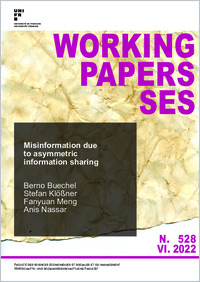Misinformation due to asymmetric information sharing
BP2-STS
- Buechel, Berno University of Fribourg, Switzerland
- Klössner, Stefan University of Vechta, Germany
- Meng, Fanyuan University of Fribourg, Switzerland
- Nassar, Anis University of Fribourg, Switzerland
- 2022
56 p.
English
On social media platforms, true and false information compete. Importantly, some messages travel much further than others, even if they concern the same topic. This fact is not reflected in models of social learning (or opinion formation) in networks. Our model fills this gap by allowing different types of information to have different decay factors and to be shared to different networks of people, incorporating asymmetries in sharing behaviors. More “shareable” information then dominates in the long run. This yields a substantial probability of misinformation, in contrast to the special case of symmetry covered by the literature. Asymptotic learning requires a perfect balance between two types of asymmetry: the product of decay factor and largest eigenvalue in the respective signal sharing networks must coincide. Approaching this balance reduces the speed of convergence and enables social learning in the shorter term. Our analysis thus suggests that policy makers, who do not know the true state, aim to mitigate asymmetries in signal sharing, e.g. by weakening echo chambers or by fostering the shareability of
cumbersome, boring messages.
cumbersome, boring messages.
- Collections
- Faculty
- Faculté des sciences économiques et sociales et du management
- Language
-
- English
- Classification
- Economics
- Series statement
-
- Working Papers SES ; 528
- License
-
License undefined
- Persistent URL
- https://folia.unifr.ch/unifr/documents/320287
Statistics
Document views: 271
File downloads:
- WP_SES_528: 332
